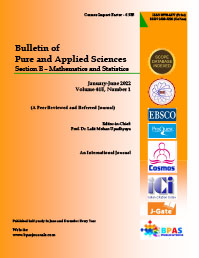The water – level dependent inventory model developed to the reference of Sonbeel lake ∗
DOI:
https://doi.org/10.48165/Keywords:
Inventory model, Optimation technique, Demand, SonbeelAbstract
Sonbeel is the second largest fresh water lake in Asia. The water-level of Sonbeel is of variable pattern. Throughout the year, the level of water is not constant. During monsoon the water level increases and from the month of October it gradually decreases. Based on this variable level of water, an inventory model is proposed depend ing on the water level, so that a better water level management of the Sonbeel lake may be developed for the optimum use of water resources.
References
Alfares, H.K. (2007). Inventory model with stock-level dependent demand rate and variable holding cost, Int. J. Production Economics, 108, 259–265.
Baker, R.C., Urban, T.L. (1988). A deterministic inventory system with an inventory level depen dent rate, Journal of the Operation Research Society, 39 (9), 823–831.
Brasington, J., El-Hames, A. and Richards, K. (1998). Hydrological modelling in humid tropical catchments, David Harper & Thomas Brown: Chichester, 313–336.
Clarke, R. and King, J. (2004) The atlas of water, Earthscan Publications, London. [5] Su, Chao-Ton, Tong, Lee-Ing and Liao, Hung-Chang. (1996). An inventory model under inflation for stock dependent consumption rate and exponential decay, Opsearch, 33, 71–82 . [6] Charnes, A. Cooper, W.W and Rhodes, E. (1978). Measuring efficiency of decision making units, American Journal of Agricultural Economics, 87, 160–179.
Chavas J.P., Ragan, P. and Michael, R. (2005). Farm household efficiency: evidence from the Gambia, Euro. J. Oper. Res., 2, 449–458.
Dutta, T.K., Pal, A.K. (1990). A note on an inventory model with inventory-level-dependent demand rate, J. Oper. Res. Soc., 41 (10), 971–975.
Das, et al. (2012). Two-warehouse production model for deteriorating inventory items with stock dependent demand under inflation over a random planning horizon, Central European Journal of Operations Research, 20(2), 251–280.
Dutta, N.and Dutta Choudhury, K. (2017). Review of the inventory models for decision making in water control management, ISOR Journal of Mathematics, 13(1), (2017), 16–21. [11] Dye, C.Y.n(2002). A deteriorating inventory model with stock-dependent demand and partial backlogging under conditions of permissible delay in payment, Opsearch, 39, 189–201. [12] Efkih, S., Feijoo, M.L. and Romero, C. (2009). Agricultural sustainable management: a normative approach based on goal programming, J. Oper. Res..Soc., 60, 534–543.
Flides, R., Nikolopoulos, K., Crone, S.F. and Syntetos, A.A. (2008). Forecasting and operational research: a review. J. Oper. Res. Soc., 59, 1150–1172.
Gupta, R. and Vrat (2009). Inventory model for stock-dependent consumption rate, Opsearch , 23 (1), 19–24.
Goh, M. (1994). EOQ models with general demand and holding cost functions. Eur. J. Oper. Res., 73(1), 50–54.
Ghosh, Santanu Kumar, Sarkar, Tania and Choudhury, Kripasindhu (2015). A multi-item in ventory model for deteriorating items in limited storage space with stock-dependent demand, American Journal of Mathematical and Management Sciences, 34 (2), 147–161.
Hwang, H., Hahn, K.H. (2000). An optimal procurement policy for items with an inventory level dependent demand rate and fixed life time, European Journal of Operation Research , 127(3), 537–545.
Nandita Dutta, Karabi Dutta Choudhury, S.S. Nath and M. Dutta Choudhury
Kemper, K.E. (2003). Rethinking groundwater management, in Caroline M. Figures, Cecilia Tor tajada & Johan Rockstr¨om (Eds.), Rethinking Water Management: Approaches to Contemporary Issues, Earthscan Publications Ltd., London, UK, 120–143.
Li, Y.P., Huang, G.H., Nie, S.L. and Liu, L. (2008). In exact multistage stochastic integer program ming for water resources management under uncertainty, Journal of Environmental Management, 88(1), 93–107.
Luwesi, C.N. (2009). An evaluation of efficiency of use of agricultural watershed resources under fluctuating rainfall regimes at Muooni Dam site, Machakos district, Kenya, Master’s Thesis, School of Pure and Applied Sciences, Kenyatta University, Kenya.
Luwesi,C.N. (2010). Hydro-Economic inventory in a changing Environment – an assessment of the efficiency of farming water demand under fluctuating rainfall regimes in semi-arid lands of South-East Kenya, Lambert Academic Publishing AG & CO.KG, Saarbrucken, Germany (ISBN 978-3-8433-7607-5).
Mandal, B.N. and Phaujdar (1989). An inventory model for deteriorating items and stock dependent consumption rate, J. Oper. Res. Soc. , 40, 483–488.
Oduol J.B.A., Hotta, K., Shankar, S. and Tsuji, M. (2006). Farm size and productive efficiency: lessons from smallholder farms in Embu District, Kenya, Kyushu University Journal of the Faculty of Agriculture , 51 (2), 449–458.
Sehring, J. (2008). The pitfalls of irrigation water pricing in Kyrgyzstan, Development, 51, 130– 134.
Subramanian, V. (2001). Water quality and quantity, in V. Subramanian and A. Ramanathan (Eds.), Ecohydrology, Capital Publishing Company, New Delhi, 241–264.
Swarp, K., Gupta, P.K. and Mohan, M. (2007). Operations Research, Sultan Chand & Sons, New Delhi.
Urban, T.L. (1995). Inventory models with the demand rate dependent on stock and shortage levels, International Journal of Production Economics, 40(1), 21–28.
Wilson, R.H. (1934). A scientific routine for stock control, Harvard Business Review, 13, 116–128.
